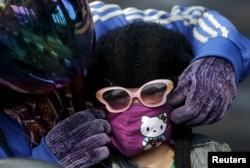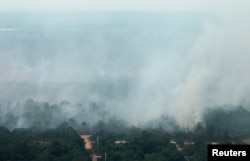Toxic fumes from the Indonesian fires that have spread a choking haze across Southeast Asia may be doing more harm to human and plant health than officials have indicated, scientists measuring the pollution say.
Farmers are expecting a poor harvest because plants have too little sunlight for normal photosynthesis, while government figures of half a million sickened by the smoke are only the "tip of the iceberg", said Louis Verchot, a scientist with the Center for International Forestry Research (CIFOR).
Meanwhile, the fires are converting carbon stored in burning peatlands into greenhouse gases, contributing to climate change.
"When the sun goes up, the whole world is yellow. On the worst day, the visibility was less than 100 meters (328 ft)," said Verchot, who led a workshop on the crisis in Central Kalimantan province last month with about 20 scientists from Indonesia, the United States and Britain.
While taking measurements on a burning 5,000-hectare (12,000-acre) plot, the scientists - equipped with gas masks and a drone - trod carefully across the ash-covered peatland to avoid calf-deep holes, hot from the smoldering underground.
They are still analyzing their data, but Verchot said they had found harmful gases in the air including ozone, carbon monoxide, cyanide, ammonia, formaldehyde, nitric oxide and methane.
"It irritates your eyes, it irritates your throat. Without a mask, I don't know how people live in this stuff," he told the Thomson Reuters Foundation by telephone from Jakarta.
Many people wear simple masks that are ineffective at filtering the dangerous compounds, or no masks at all, he added. The smoke from the fires on Borneo, Sumatra and elsewhere in Indonesia has spread to neighboring Singapore, Malaysia, the Philippines and Thailand.
Local media reported that schools in Central Kalimantan had closed for almost five weeks over the past two months, while the haze killed at least 10 people and sickened 504,000 on Borneo and Sumatra - though Verchot believes the figure is much higher.
"People in rural areas seek medical attention when it's really bad. I'm pretty sure it's an underestimate. This must be the people who are seriously affected," he said.
Carbon Monoxide in Hotel
Daytime flights to Central Kalimantan have been postponed to night when winds blow the all-permeating smoke in a direction that improves visibility for landing, Verchot said.
Martin Wooster, a professor at King's College London who joined Verchot on the trip, tested his equipment in his hotel room, several kilometers from the fires, and found 30 molecules of carbon monoxide per million molecules of air - enough to trigger a household carbon monoxide detector.
Outside near the burning peatlands, Wooster's preliminary data indicates more than 1,000 micrograms of particulate matter per cubic meter of air, and sometimes up to 2,000.
The U.S. Environmental Protection Agency considers any amount over 300 micrograms per cubic meter hazardous.
"I'd never seen anything like that ... I thought it was catastrophic for the local population, having to live with that level of air pollution for such an extended period of time," said Wooster, who has studied burning biomass in Mexico, Canada, South Africa and Britain.
"The geographic coverage of the smoke was enormous. You could drive for many tens of kilometers and still be in thick smoke. And it is persisting for weeks, even months," he said by telephone from London.
Predictable and Preventable
The smokiest burn sites in Indonesia are the tropical peatlands that large companies and small-scale farmers have deforested and drained for agriculture, palm oil and wood products such as pulp and paper. Lacking a forest canopy, the dried-out peatlands are prone to fire.
Once considered a problem mainly in drought years, the smoldering fires on these "forest cemeteries" of dried peat and wood debris are now occurring annually.
This year has been particularly bad due to lower rainfall linked to the El Nino weather phenomenon, although recent downpours have doused some of the fires and reduced the haze.
While the Indonesian government is struggling to control the crisis, Verchot described the haze as "totally preventable."
"This was predicted. The solution is not reacting to the crisis, it's preventing the crisis," he said. "It requires serious effort. It's something the government could do if they wanted to."
CIFOR has urged a reduction in forest conversion and peatland cultivation, better income opportunities in rural areas, and restoration of degraded peatlands.
Greenpeace has called on the pulp and palm oil industries to implement an immediate ban on forest and peatland development, and for peatlands to be reflooded to mitigate fire risks.
To discourage palm oil-related forest destruction, the Union of Concerned Scientists and other green groups have lobbied for companies to trade and use palm oil that is not produced in a way that causes deforestation.
















